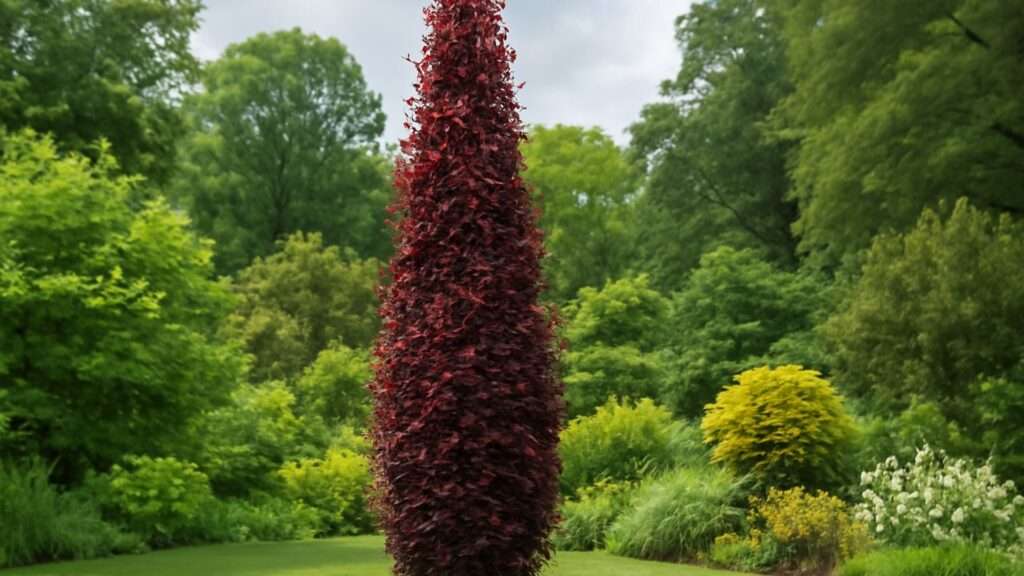
Red Obelisk Beech: The Ultimate Care Guide for Growing and Maintaining This Stunning Tree
Looking to add a touch of elegance and color to your garden? 
In this ultimate guide, we’ll walk you through everything you need to know about growing and maintaining your Red-leaved obelisk beech tree. From planting tips to ongoing maintenance, we’ll provide practical advice that ensures your tree grows healthy and vibrant. Keep reading to discover how to make the most of this beautiful addition to your garden!
Table of Contents
ToggleWhat is a Red Obelisk Beech? 
The Red-leaved obelisk beech tree (Fagus sylvatica ‘Red Obelisk’) is a stunning ornamental tree that stands out in any garden or landscape. Known for its narrow, columnar shape and striking red foliage, this tree offers year-round beauty and a unique touch to your outdoor space.
Unlike the traditional wide-beamed beech tree, the Red Obelisk Beech grows in a more upright, obelisk-like form, making it ideal for tight spaces or as a focal point in smaller gardens. The tree’s deep purple-red leaves are its most distinctive feature, providing a dramatic contrast against green lawns or surrounding plants.
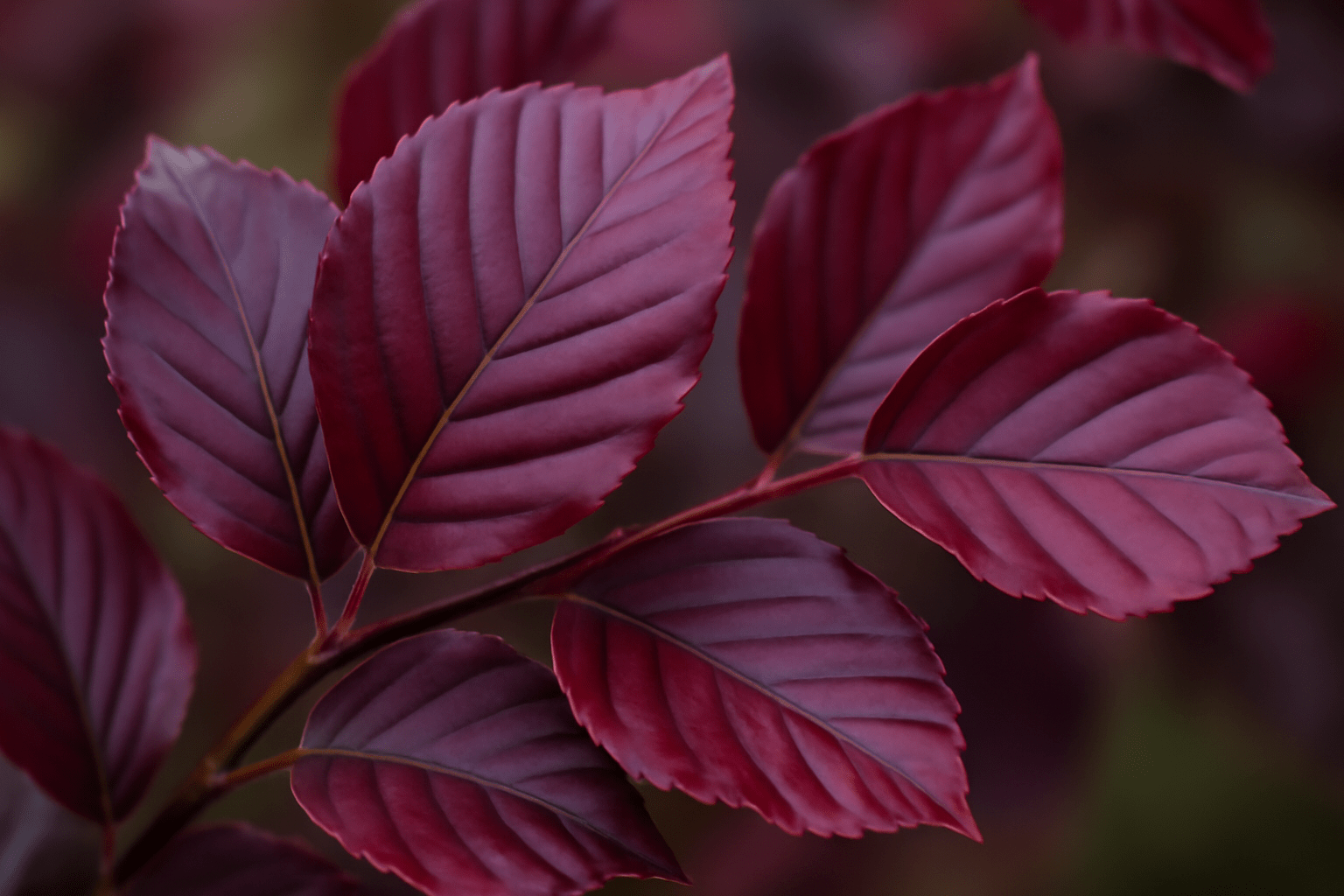
In the spring and summer, the tree’s foliage glows with a rich, vibrant color. As the seasons change, the leaves turn a deeper red, offering a wonderful sight throughout the year. By fall, the Red-leaved obelisk beech tree also produces small, inconspicuous brown flowers, followed by spiky fruit, adding another layer of interest.
Whether you’re an experienced gardener or a beginner, the Red-leaved obelisk beech tree is relatively easy to care for and can thrive in a variety of soil types, making it a fantastic addition to your landscape.
Why Choose a Red Obelisk Beech?
- Compact and Vertical: Perfect for small gardens or tight spaces.
- Seasonal Beauty: Enjoy stunning red foliage that changes color throughout the year.
- Low Maintenance: With the right conditions, this tree requires minimal care.
Now that you know what a Red-leaved obelisk beech tree is, let’s dive into how to properly care for it and ensure it thrives in your garden!
Ideal Growing Conditions for Your Red Obelisk Beech 
To ensure your Red-leaved obelisk beech tree thrives and becomes the stunning tree you envision, it’s essential to provide the right growing conditions. This unique tree is known for its tall, narrow form and striking foliage, making it a popular choice for landscapes. Here’s how you can create the perfect environment for it:
1. Location: Full Sun or Partial Shade 
The Red Obelisk Beech prefers full sun to partial shade. Ideally, it should receive at least 4 to 6 hours of direct sunlight per day. A sunny spot will promote vibrant leaf color and healthy growth. However, if you live in a hotter climate, partial shade during the afternoon is preferable to prevent leaf scorch.

2. Soil Type: Well-Draining, Moist, and Slightly Acidic 
This tree thrives in moist, well-draining soil that’s slightly acidic (pH 5.5-6.5). Red-leaved obelisk beech tree doesn’t tolerate waterlogged conditions, so make sure the soil drains well to prevent root rot. If your soil is heavy clay, improve drainage by mixing in organic matter like compost. The soil should be rich in nutrients to support healthy growth, so adding some organic mulch around the base can help retain moisture and keep roots cool during summer.
3. Space: Room to Grow 
The Red-leaved obelisk beech tree is known for its narrow, columnar shape, but it still requires ample space to grow. Plant it at least 6-8 feet away from structures or other trees. Give it enough space to stretch upwards and maintain airflow to reduce the risk of disease.
4. Watering: Consistent Moisture 
While the tree is drought-tolerant once established, it prefers consistent moisture, especially during its early years. Water it regularly, ensuring the soil remains moist but not soggy. During hot, dry periods, it will appreciate extra water, but make sure to avoid letting water pool around its roots.
5. Protection from Strong Winds 
This tree can be susceptible to wind damage due to its narrow structure. If you live in a windy area, consider planting it in a sheltered spot or near a windbreak to protect its delicate branches.
By providing the right location, soil, and care, your Red Obelisk Beech will thrive, becoming a standout feature in your garden for years to come!
How to Plant a Red Obelisk Beech Tree 
Planting a Red-leaved obelisk beech tree tree is an exciting and rewarding experience! With its striking vertical form and vibrant foliage, it can become a stunning focal point in your garden. Follow these simple steps to ensure your tree thrives for years to come:
1. Choose the Right Location 
Select a spot that receives full sun to partial shade. The Red Obelisk Beech thrives best in areas with at least 4-6 hours of direct sunlight daily. Make sure the soil is well-drained and not too soggy to prevent root rot. Avoid planting in areas where water tends to pool, as this can harm the tree’s roots.
2. Prepare the Soil 
Before planting, it’s important to prepare the soil properly. Loosen the soil to a depth of about 12 inches (30 cm) around the planting site. If your soil is heavy or clay-like, mix in some organic compost to improve drainage and nutrient levels. Red-leaved obelisk beech tree trees prefer slightly acidic to neutral soil pH (around 6.0 to 7.0).
3. Dig the Hole 
Dig a hole that is twice the width of the tree’s root ball but only as deep as the root ball itself. This ensures the roots have room to spread out without being buried too deep. Gently remove the tree from its pot, being careful not to damage the roots.
4. Plant the Tree 
Place the tree in the center of the hole and make sure the top of the root ball is level with the surrounding soil. If the tree is too deep in the hole, it could suffocate. Once positioned, fill the hole with the prepared soil mixture, pressing down gently to remove air pockets.
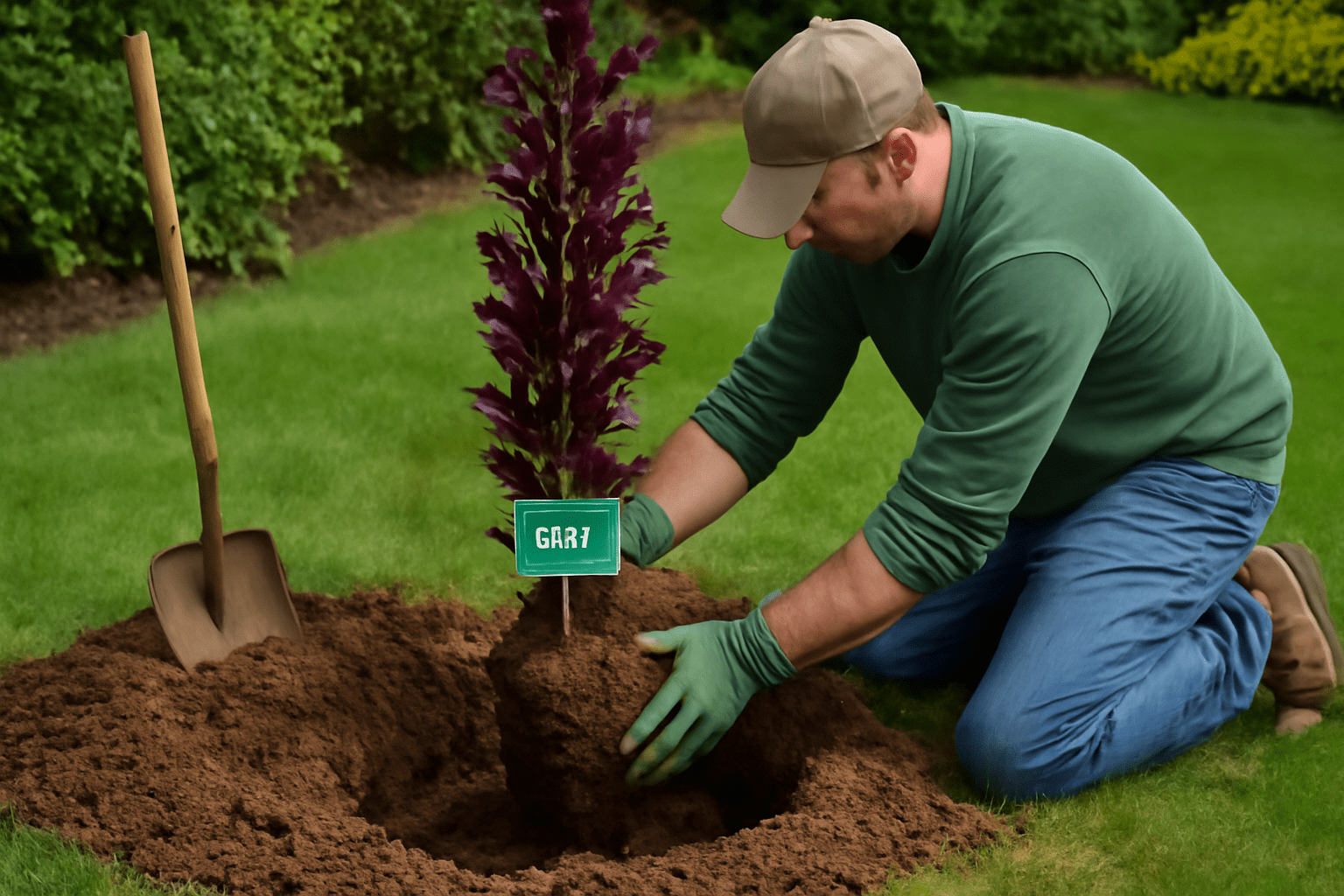
5. Water Generously 
After planting, give your Red-leaved obelisk beech tree a deep watering. This helps settle the soil around the roots and ensures good contact with the soil. Keep the tree well-watered during its first few months, especially during dry spells. However, avoid over-watering, as the tree doesn’t like soggy conditions.
6. Mulch Around the Base 
Apply a 2-3 inch layer of mulch around the base of the tree. This helps retain moisture, suppresses weeds, and keeps the soil temperature stable. Just make sure to keep the mulch a few inches away from the tree trunk to prevent rot.
7. Staking (Optional) 
If you’re planting in a windy area, you may want to stake the tree for the first couple of years. Use soft ties to avoid damaging the trunk and roots. The tree will eventually establish itself and grow strong enough to stand on its own.
By following these simple planting steps, you’ll give your Red-leaved obelisk beech tree the best start in life! In no time, it will begin to grow into a stunning vertical tree that adds beauty and elegance to your garden.
Happy planting!
Caring for Your Red Obelisk Beech Tree 
Caring for your Red-leaved obelisk beech tree tree is a rewarding experience that will ensure its stunning beauty thrives for years to come. Whether you’re a gardening novice or a seasoned pro, this guide will provide you with simple, effective steps to keep your tree healthy and vibrant. Here’s what you need to know!
1. Planting Location Matters 
The first step in caring for your Red Obelisk Beech is choosing the right spot. This tree loves full sun but can tolerate partial shade. Make sure it gets at least 4-6 hours of direct sunlight each day to bring out its rich, red foliage.
The soil should be well-drained and slightly acidic (pH 6.0-6.5). Avoid planting it in areas with poor drainage or heavy clay, as this can lead to root rot. A loamy soil mix with organic matter will be perfect!
2. Watering: Keep it Just Right 
Water your Red-leaved obelisk beech tree regularly, especially during its first few years of growth. 
In the winter, reduce watering, but don’t let the soil dry out completely. A mulch layer around the base will help retain moisture and keep the roots cool.
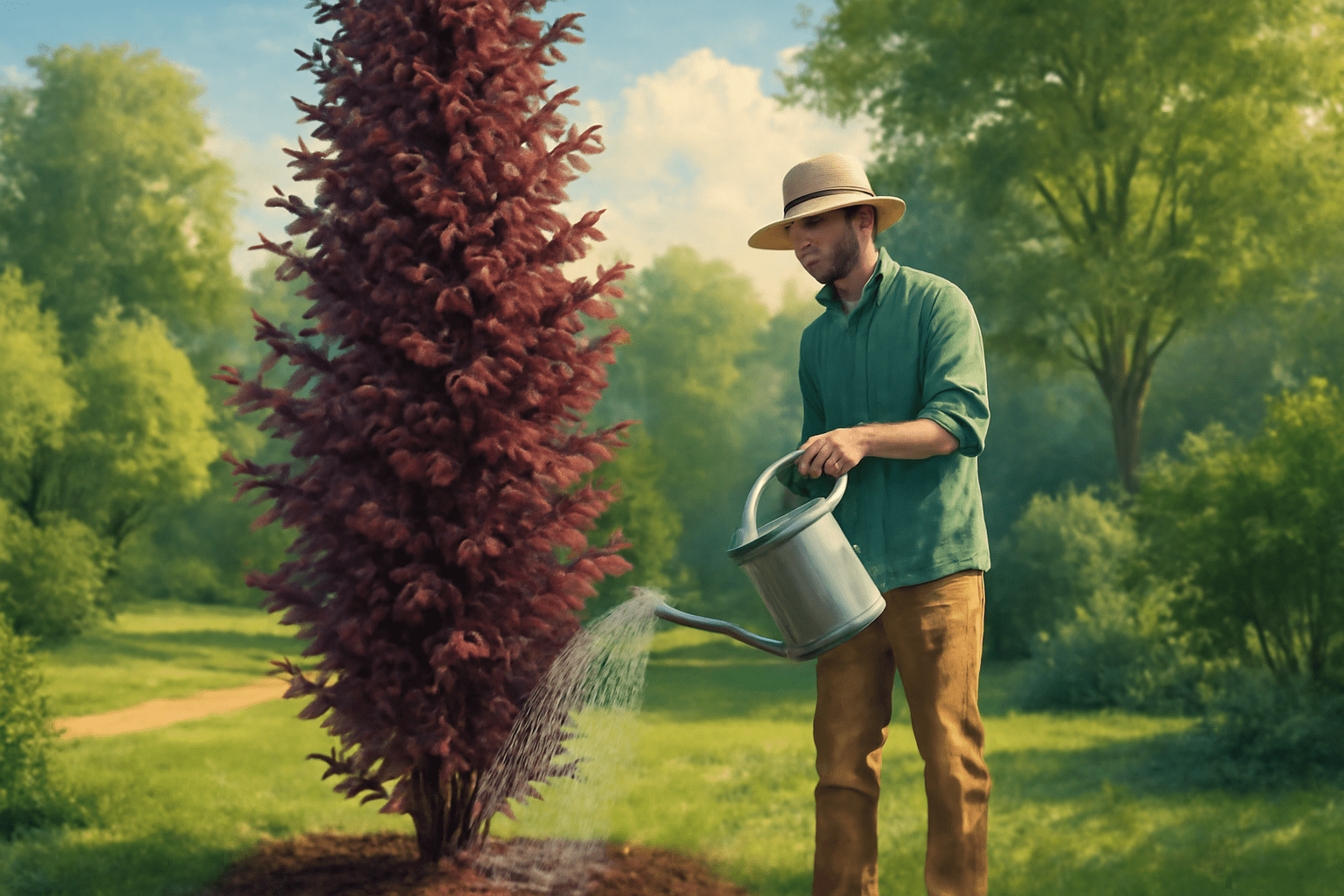
3. Pruning for Health and Shape 
Pruning your Red-leaved obelisk beech tree helps maintain its elegant shape and promotes strong growth. Aim to prune in late winter or early spring before new growth begins. This is the best time to remove any dead, diseased, or damaged branches.
Cut back any crossing branches to improve air circulation. This prevents fungal issues and ensures your tree stays healthy. If you want to shape the tree, trim lightly to encourage a neat, upright growth pattern. Just be careful not to over-prune!
4. Fertilizing for Growth 
Feed your tree in early spring with a slow-release, balanced fertilizer. This will give it the nutrients it needs for strong growth during the growing season. 
If you’re using compost or organic mulch, it can help improve soil quality and give your tree a natural nutrient boost.
5. Watch Out for Pests and Diseases 
While the Red Obelisk Beech is relatively resistant to pests, it’s still important to stay vigilant. Check regularly for signs of aphids, scale insects, or leaf spots. If you notice any, treat them with an eco-friendly insecticide or simply rinse the leaves with water.
Ensure your tree has good air circulation and avoid overhead watering to prevent fungal diseases like powdery mildew.
6. Winter Care: Protecting Your Tree 
In colder climates, your Red-leaved obelisk beech tree may need some extra care during the winter months. If temperatures drop below freezing, consider wrapping the trunk with burlap or a tree guard to prevent winter damage. Mulch around the base to keep the roots insulated.
While this tree is hardy, it’s always a good idea to provide some winter protection if you’re in a particularly harsh climate.
By following these simple care tips, your Red-leaved obelisk beech tree tree will grow strong, healthy, and stunning for years to come! 
Common Problems and Solutions for Red Obelisk Beech Trees 
Red Obelisk Beech trees are beautiful and relatively easy to care for, but like any plant, they can face a few challenges. Here are some common issues you might encounter and practical solutions to keep your tree thriving:
1. Leaf Browning or Yellowing 
If you notice the leaves turning brown or yellow, it could be due to several factors:
- Watering issues: Either too much or too little water can cause this. Ensure your tree gets well-draining soil and water only when the top inch of soil is dry.
- Nutrient deficiency: Red-leaved obelisk beech tree trees thrive in nutrient-rich soil. Use a balanced fertilizer once a year in early spring to promote healthy growth.
- Pests: Aphids or scale insects can also cause leaf discoloration. Regularly check for pests and treat with organic insecticides if needed.
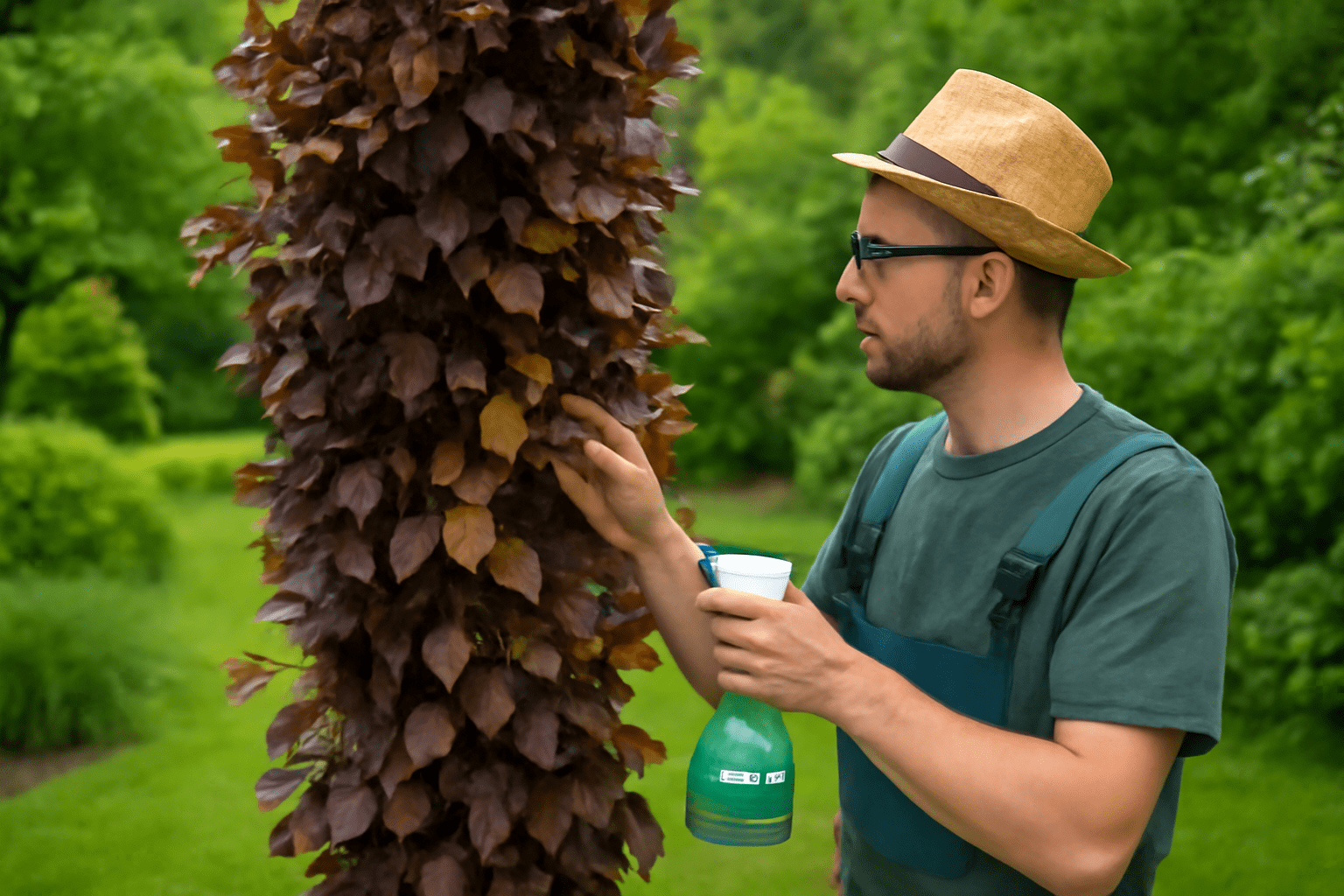
Solution: Maintain a consistent watering schedule, fertilize annually, and inspect for pests to prevent leaf damage.
2. Stunted Growth 
If your Red Obelisk Beech tree isn’t growing as expected, it could be stressed by:
- Poor soil quality: Beech trees prefer slightly acidic, well-drained soil. If the soil is too compacted or alkaline, the tree might struggle.
- Lack of sunlight: Although tolerant of partial shade, this tree still requires some sunlight to thrive. Too much shade can stunt growth.
Solution: Ensure your tree is planted in soil that drains well and has the right pH. Consider relocating the tree to a spot that gets a few hours of direct sunlight each day.
3. Leaf Drop in Fall 
It’s natural for Red-leaved obelisk beech tree trees to shed their leaves in the fall, but if it happens too early or too drastically, it could indicate stress:
- Overwatering: When the tree’s roots sit in waterlogged soil, it can cause stress, leading to premature leaf drop.
- Pests or diseases: Certain pests, like the beech scale, can weaken the tree and cause early leaf drop.
Solution: Ensure proper drainage and water only when needed. Regularly inspect for pests and treat accordingly to prevent stress.
4. Bark Peeling or Damage 
While peeling bark is normal for mature trees, excessive peeling or damage can be a sign of:
- Frost damage: Extreme winter temperatures can cause the bark to crack and peel.
- Mechanical injury: Physical damage, like lawnmower strikes or pruning mistakes, can harm the tree.
Solution: Protect your tree from mechanical damage and wrap the trunk in protective materials during winter to prevent frost damage.
5. Root Rot 
Red-leaved obelisk beech tree trees are susceptible to root rot if their roots are consistently waterlogged.
- Symptoms: Wilting, yellowing leaves, and mushy, dark roots.
- Cause: Poor drainage or excessive watering.
Solution: Ensure the tree is planted in soil that drains well and avoid overwatering. If root rot is suspected, remove the affected roots and replant the tree in well-draining soil.
Conclusion 
With proper care and attention, your Red-leaved obelisk beech tree can overcome these common challenges and grow into a stunning, healthy tree. Regularly check for pests, maintain good watering habits, and provide your tree with the nutrients it needs for a beautiful, thriving landscape. Happy gardening!
How to Encourage Healthy Growth in Your Red Obelisk Beech 

The Red Obelisk Beech is a stunning tree known for its vibrant, vertical growth and striking reddish-purple foliage. But to truly thrive, this tree needs the right care. Here are some essential tips to ensure your Red-leaved obelisk beech tree grows strong and beautiful:
1. Plant in the Right Spot 
Choosing the right location is crucial. Red-leaved obelisk beech tree trees thrive in full sun to partial shade. Aim for a spot that gets at least 4–6 hours of sunlight per day for optimal growth. Too much shade can cause poor foliage color, while too much sun can dry out the leaves. Make sure the spot has well-drained soil to prevent root rot. A slightly acidic to neutral soil pH is ideal!
2. Water Regularly, But Not Too Much 
Keep the soil consistently moist, especially during dry spells. However, avoid overwatering as waterlogged soil can lead to root rot. The key is well-drained soil and watering deeply but infrequently. Water the tree at the base, not on the leaves, to reduce the risk of fungal diseases.
3. Mulch for Moisture & Protection 
Applying a layer of mulch around the base of the tree helps retain moisture, regulate soil temperature, and prevent weeds. Use organic mulch like wood chips or bark—this will slowly decompose and add nutrients to the soil. Just be sure to keep the mulch a few inches away from the trunk to prevent rot.
4. Prune for Shape and Health 
Pruning your Red-leaved obelisk beech tree is important for both its appearance and health. Remove dead, diseased, or damaged branches regularly to encourage new growth. Early spring is the best time to prune, before the tree begins its growing season. Be sure to avoid heavy pruning, as this can stress the tree. A light trim will help maintain its signature upright form.
5. Fertilize Annually for Strong Growth 
Feed your Red Obelisk Beech with a balanced fertilizer once a year, preferably in the spring. Look for a slow-release granular fertilizer or organic options like compost. This will provide a steady supply of nutrients throughout the growing season, helping the tree develop strong roots and vibrant leaves.
6. Watch for Pests & Diseases 
Although Red-leaved obelisk beech trees are generally resistant to pests, keep an eye out for common problems like aphids, leaf miners, or fungal infections. If you spot any issues, treat them early with an organic pesticide or fungicide. Regularly inspect the tree’s leaves and branches to catch potential problems before they spread.
7. Provide Winter Protection 
While this tree is hardy, young Red Obelisk Beeches can benefit from a bit of winter protection. Wrap the trunk with burlap or tree wrap to protect it from harsh winds and freezing temperatures. Adding mulch around the base in late fall also helps insulate the roots from the cold.
By following these simple steps, you’ll be well on your way to growing a healthy, thriving Red-leaved obelisk beech tree that adds beauty and elegance to your garden year after year!
With these tips, you can ensure that your Red-leaved obelisk beech tree grows in the best possible conditions, looking stunning all year round!
Conclusion
The Red Obelisk Beech is truly a remarkable tree, offering stunning vertical growth and vibrant seasonal colors that can transform any garden or landscape. With its narrow, upright form and striking red-purple foliage, it’s a perfect choice for smaller spaces or for adding a dramatic focal point to your outdoor space.
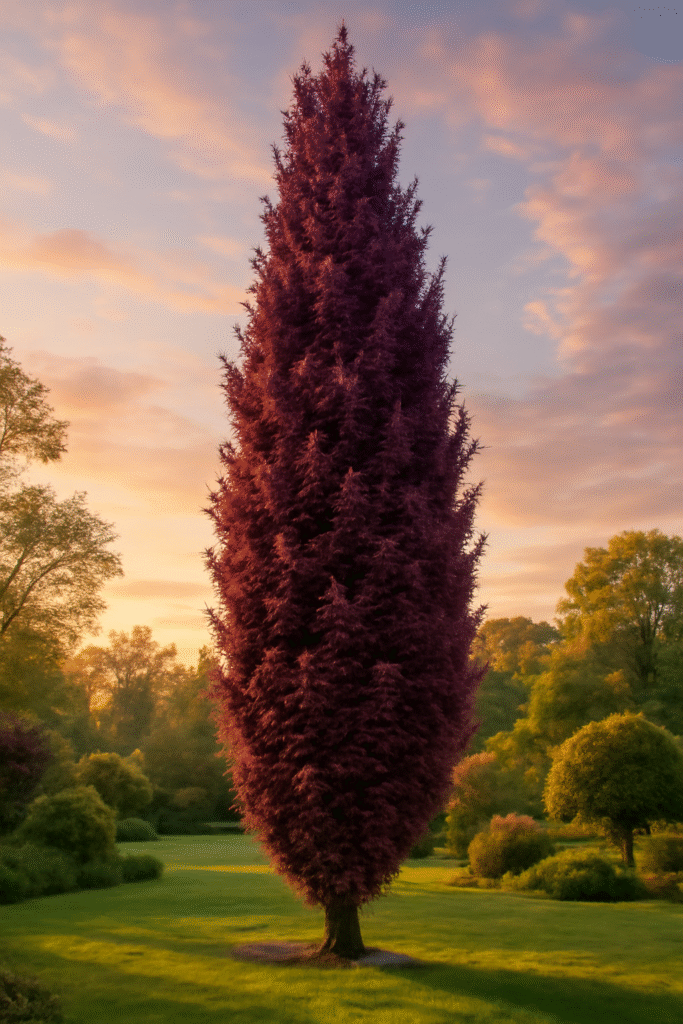
By following the care tips in this guide—from selecting the right location to regular pruning and monitoring for pests—you can ensure your Red Obelisk Beech thrives and remains a healthy, beautiful tree for years to come. Whether you’re just planting one or tending to an established tree, your efforts will pay off with a graceful and eye-catching addition to your garden.
Start caring for your Red-leaved obelisk beech tree today, and enjoy the long-lasting beauty it brings to your landscape!
Frequently Asked Questions(FAQ)
How tall does a Red Obelisk Beech tree grow?
The Red Obelisk Beech can reach a height of 30 to 40 feet with a width of 10 to 15 feet at maturity. Its upright, columnar shape makes it ideal for smaller gardens or areas where space is limited.
When is the best time to plant a Red Obelisk Beech tree?
The best time to plant a Red Obelisk Beech is in early spring or fall. These seasons provide mild temperatures, which help the tree establish roots before the heat of summer or the cold of winter.
How fast does a Red Obelisk Beech grow?
The Red Obelisk Beech grows at a moderate rate, adding about 12–18 inches of height per year under optimal growing conditions. While it’s not a fast grower, it matures into a stunning tree over time.
How do I prune a Red Obelisk Beech tree?
Prune your Red Obelisk Beech in late winter or early spring before new growth starts. Remove any dead, damaged, or diseased branches, and shape the tree to maintain its vertical form. Regular pruning will help keep the tree healthy and attractive.
What soil does a Red Obelisk Beech prefer?
Red Obelisk Beech prefers slightly acidic, well-draining soil. It thrives in rich, loamy soil, but it can tolerate a range of soil types as long as it is not too soggy or poorly drained.
Can the Red Obelisk Beech tree survive in cold climates?
Yes, the Red Obelisk Beech is hardy in USDA zones 4–7, meaning it can tolerate cold climates. However, it’s essential to protect young trees from extreme frost or drying winds during harsh winters.
How do I maintain the vibrant red foliage of my Red Obelisk Beech?
To maintain the stunning red-purple foliage of the Red Obelisk Beech, ensure it gets enough sunlight, as its color deepens in full sun. Avoid planting it in overly shaded areas to prevent dull-colored leaves.
Is the Red Obelisk Beech tree suitable for small gardens?
Yes, the Red Obelisk Beech is ideal for small gardens because of its narrow, columnar shape. Its upright growth allows it to fit into tight spaces, making it perfect for urban or suburban landscaping.



